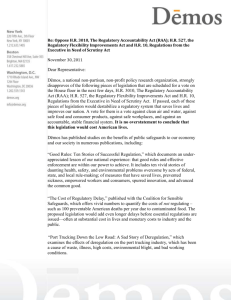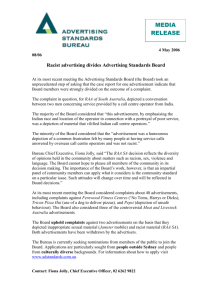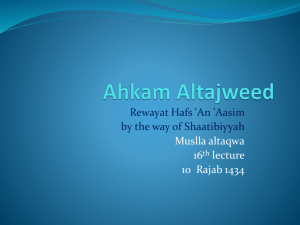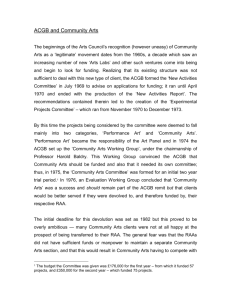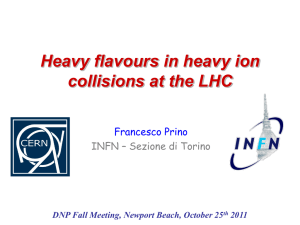ppt - INFN - Torino Personal pages
advertisement
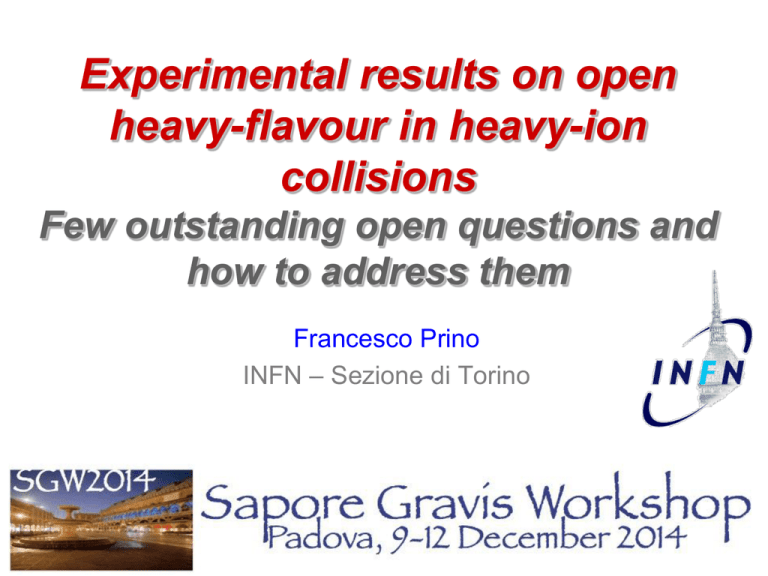
Experimental results on open heavy-flavour in heavy-ion collisions Few outstanding open questions and how to address them Francesco Prino INFN – Sezione di Torino Charm and beauty quarks in heavy-ion collisions K p D e,m D n Produced in partonic processes with large Q2 on short time scale Production in QGP expected to be B negligible pQCD can be used to calculate initial cross sections Traverse the “full evolution” of the hot and dense medium b quark c quark Lose energy via elastic collisions with the medium constituents and gluon radiation Flavour conserved in the interactions with the QGP Excellent probes of the properties of the medium: transport coefficients, energy loss mechanism, collectivity, thermalization) 2 Probing the medium properties Hierarchy expected due to colour-charge and quark-mass dependence of in-medium parton energy loss: E gluon Eu ,d ,s Ec Eb coupling needed Expectation: v2(B) < v2(D) Are re-scatterings with the medium strong enough to make charm (and beauty) quarks thermalize in the medium? Reaction plane Flow Out-of-plane Interactions with the medium constituents can transfer to charm and beauty quarks the collective flow (radial and elliptic) of the medium Large mass: frequent interactions with large Flow Reflected into: RAA(B) > RAA(D) > RAA(p)? Y In-plane X 3 Heavy flavour reconstruction Semi-leptonic decays (c,b) Displaced J/y (from B decays) + m J/y e,m m- B Lxy Primary vertex B,D jet b-tagging Full reconstruction of D meson hadronic decays D0 K- p+ D+ K- p+ p+ D*+ D0 p+ Ds+ K- K+ p+ 4 What have we learned? In-medium energy loss PHENIX, PRL 109 (2012) 242301 Strong suppression of HF yield at intermediate and high pT Final state effect due to in-medium energy loss (by comparing to d-Au and p-Pb) RAA(HFE,D) ≈ RAA(p) CMS, PAS HIN-12-014 ALICE, arXiv: 1405.3452 5 What have we learned? Beauty vs. charm RAA D meson (ALICE) and J/y←B (CMS) RAA vs. centrality in pT ranges tuned to have <pT(D)> ≈ <pT(B)> ≈ 10-11 GeV/c Expectation from parton-mass dependent energy loss: Ec > Eb Clear indication of RAA(B) > RAA(D) for 8<pT(D)<16 GeV/c Also for 5<pT<16 GeV/c Described by model calculations with quark-mass dependent energy loss Djordjevic, Djordjevic, PRL112 (2014) 042302 MC@sHQ+EPOS: Gossiaux et al., arXiv:1409.0900 WHDG: Horowitz et al., J Phys. G38 (2011) 124114 6 What have we learned? Beauty jets at high pT CMS, PAS-HIN-14-007 CMS, PRL 113 (2014) 132301 RAA of b-jets found to be consistent with that of inclusive jets (dominated by light quarks and gluons) at high pT (>80 GeV/c) Mass effect on parton energy loss expected to be small at large pT 7 What have we learned? Flow/collectivity Positive elliptic flow at RHIC and LHC Comparable with charged particle v2 Suggests that charm quarks take part in the collective expansion of the system? Elliptic flow at low pT also sensitive to: Interactions with medium constituents: Collisional more effective than radiative processes in building v2 Hadronization mechanism: Coalescence increases radial and elliptic flow at intermediate pT ALICE, PRL 111 (2013) 102301 STAR, arXiv: 1405.6348 8 What have we learned? Collectivity in small systems? Double-ridge structure observed in the angular correlations between HF decay electrons and charged hadrons in p-Pb collisions Similar to the one observed in the light-flavour sector ( ALICE, PLB719 (2013) 29 ) Suggests that the mechanism generating the double ridge is at work also for heavy flavours CGC in initial state? Dusling, Venugopalan, PRD87 (2013) 094034 Hydrodynamics in final state? Bozek, Broniowski, PLB718 (2013) 1557 To be considered: collective flow in small systems ( Sickles, arXiv:1309.6924) would modify the HF hadron pT spectra in addition to nuclear modification 9 of PDFs, kT-broadening, cold-nuclear-matter energy loss Few outstanding open questions Charm vs. light quark energy loss Expectation Ec < Eu,d,s< Eg vs. observation RAA(D) ≈ RAA(p) Charm hadrochemistry: Ds and Lc Sensitive to hadronization mechanism (coalescence vs. fragmentation) Low-pT D-mesons: LHC vs. RHIC Interplay between radial flow, coalescence, shadowing and energy loss Measurements at lower collision energy RAA>~1 measured at √s=62.4 GeV Other handle to study the interplay between radial flow, coalescence, kTbroadening and energy loss Path length dependence of energy loss Allow to constrain the contribution of collisional and radiative processes? Beauty quark energy loss at low and intermediate pT Low pT (<10 GeV/c): mass effect on energy loss + radial flow? Intermediate pT: at which pT does RAA(b) become compatible with RAA(light)? Elliptic flow of charm (and beauty) hadrons Is v2 of D mesons and HFE due to charm quarks participating in the collective flow? Or is it due to hadronization via coalescence with light quarks from the bulk? Collectivity in small systems also in the HF sector? Or Colour Glass Condensate? Crucial to assess cold nuclear matter effects in the initial and final state 10 Charm vs. light Similar RAA of D mesons and pions both at RHIC and LHC) Described by models including Mass and colour charge dependent E loss Different momentum spectra of charm quarks, light quarks and gluons Different fragmentation function (harder for charm than for light quarks and gluons) Djordjevic, Djordjevic, PRL112 (2014) 042302 Hint for RAA(D) > RAA(p) for pT<5 GeV/c? More data needed to study the (small) effect of c-quark mass at low pT Eg>Euds ≥Ec RAA(g)<RAA(uds)≤RAA(c) Fragmentation c→D RAA(D)≈RAA(c) Distortion due to fragmentation RAA(h)≈RAA(uds)>RAA(g) 11 The strange frontier Ds+ results in Pb-Pb at low pT (<6 GeV/c) might hint at an increased ratio Ds/non-strange D in Pb-Pb collisions at √s=2.76 TeV More statistics needed to conclude on the predicted enhancement of the strange/non-strange D meson yield at low/intermediate pT if charm hadronizes via recombination in the medium Important also for the interpretation of RAA(D) vs. RAA(p) Kuznetsova, Rafelski, EPJ C 51 (2007) 113 He, Fries, Rapp, PRL 110 (2013) 112301 12 The baryon frontier ALICE, PRL 111 (2013) 222301 STAR, PRL 108 (2012) 072301 Enhancement of baryon/meson ratios at intermediate pT for light flavour hadrons in central A-A collisions at RHIC and LHC Described by hadronization via parton-recobination and radial flow At high pT the baryon/meson ratio is consistent with pp results Dominated by hard processes and hadronization via fragmentation Is baryon/meson enhanced also in the HF sector? With larger data samples Lc could become accessible at the LHC 13 Important also for the interpretation of RAA(D) vs. RAA(p) The low-pT frontier Bump in D meson RAA at √s=200 GeV Due to charm quark radial flow/coalescence Nevents(STAR)=2.4∙108 Nevents(ALICE)=1.6∙107 At LHC energy: More shadowing, different effect of the radial flow on RAA (less steep spectrum in pp) Some models (e.g. TAMU) describe both results Need more precise measurements at the LHC down to pT=0 More statistics + pp reference at same energy All spectra normalized to unity 14 The low-energy frontier PHENIX, arXiv:1405.3301 He, Fries, Rapp, arXiv:1409.4539 Yield of HF decay electrons at √s=62.4 GeV enhanced with respect to binary scaled pp collisions Large uncertainties, pp reference from ISR experiments Described by TAMU model as an interplay between different effects: kT-broadening, radial flow, coalescence and in-medium energy loss Important to: improve precision, pp reference from same experiment, separate c and b 15 The beauty frontier Low pT region (<6 GeV/c) and intermediate pT (20-80 GeV/c) to be explored HF decay electrons, b-jets at lower pT, full reconstruction of B mesons? CMS, PRL 113 (2014) 132301 CMS, PAS HIN-12-014 16 Collectivity and thermalization ALICE, PRC90 (2014) 034904 Beraudo et al., arXiv:1410.6082 Positive HF v2 observed at RHIC and LHC at low pT: Due to charm quarks participating in the collective flow? Or due to coalescence with a light quark from the bulk? More statistics at LHC energy could allow to: Constrain energy loss (collisional/radiative) and hadronization (coalescence/fragmentation) mechanisms First measurement of beauty v2 Panta rei? ( Hracleito, ~500 b.C.) 17 Elliptic flow at high pT ALICE, PRC90 (2014) 034904 PHENIX, PRC 84 (2011) 044905 Current v2 measurements at high pT not yet conclusive Positive v2 at high pT expected due to in-medium energy loss Sensitive to path length dependence of parton in-medium energy loss Different dependence of the partonic energy loss on the in-medium path length expected for collisional and radiative processes (linear vs. ~ quadratic) More statistics needed to constrain HF energy loss models exploiting also high-pT v2 18 Data vs. Theory ALICE, PRC90 (2014) 034904 Simultaneous description of HF decay electron RAA and v2 is challenging for theoretical models Data can start to constrain energy loss models E.g.: models that include collisional energy loss in an expanding medium + coalescence better reproduce the measured v2 Next steps: more systematic comparisons data vs. theory + new observables 19 New observables (with larger data samples) More differential measurements to better constrain model calculations Examples: Angular correlations (D-hadron, electronhadron, electron electron) in Pb-Pb and IAA Higher-order flow harmonics (v3) Triangular flow more enhanced than elliptic flow in a purely collisional scenario with respect to the collisional+radiative case Higher-order Fourier coefficients more sensitive incomplete coupling of heavy quarks to the medium Nahrgang et al., arXiv:1410.5396 20 Few outstanding open questions Colour charge and quark mass dependence of energy loss Expectation Ec < Eu,d,s< Eg vs. observation RAA(D) ≈ RAA(p) Extend pT range of beauty RAA measurements Energy loss mechanism: collisional vs. radiative Path length dependence of energy loss (via v2 at high pT) Constrained also by elliptic flow at low pT? Hadronization mechanism: coalescence vs. fragmentation Measure Ds with reduced uncertainties and Lc Constrained also by more precise RAA and v2 measurements at low pT Crucial to assess cold nuclear matter effects in the initial and final state Interplay between radial flow, coalescence, shadowing, kT-broadening and energy loss in the measured RAA D mesons at the LHC down to pT=0 and with reduced uncertainties More precise measurements at lower collision energy More differential measurements: e.g. correlations and IAA Collectivity and thermalization More precise charm v2 and RAA measurements at low pT Beauty v2 and higher harmonics accessible with more statistics at the LHC To address these questions and eventually access the QGP transport 21 coefficients we need a systematic comparison of data vs. theory Backup 22 D meson and pion RAA Djordjevic, Djordjevic, PRL112 (2014) 042302; arXiv:1307.4098 23 D meson and pion RAA Similar RAA of D mesons and pions both at RHIC and LHC) Described by models including Mass and colour charge dependent E loss Different momentum spectra of charm quarks, light quarks and gluons Different fragmentation function (harder for charm than for light quarks and gluons) Djordjevic, Djordjevic, PRL112 (2014) 042302; arXiv:1307.4098 24 D meson RAA: LHC vs RHIC same theoretical model D meson RAA quite different for 1<pT<2 GeV/c Recombination + radial flow? Stronger effect at RHIC because of steeper dN/dpT? Different role of shadowing at low pT at the two energies? 25 HFE (and HFM) v2 at RHIC, LHC PHENIX, PRC 84 (2011) 044905 Similar v2 of HFE at midrapidity at RHIC and LHC Maybe slightly larger at the LHC, although compatible within uncertainties At the LHC: v2 of HF decay electrons at midrapidity compatible with that of HF decay muons at forward rapidity 26 Radial flow in small systems? Sickles, arXiv:1309.6924 Radial-flow interpretation of HF data in pPb collisions Final state effect in addition to “usual” coldnuclear matter effects in the initial state (nPDFs - shadowing/antishadowing -, kTbroadening, cold-nuclear-matter energy loss) Smaller modification expected at LHC energies 27
